Galactooligosaccharide Production Using Immobilized Aspergillus oryzae β-Galactosidase, Part I: Characterization and Influence of Reaction Conditions
Abstract
1. Introduction
2. Results and Discussion
2.1. Characterization of Free β-Galactosidase
2.2. Characterization of Immobilized β-Galactosidase
2.3. Effect of Reaction Conditions on GOS Synthesis
3. Materials and Methods
3.1. Materials
3.2. β-Galactosidase Immobilization
3.2.1. Protocol I
3.2.2. Protocol II
3.2.3. Protocol III
3.2.4. Protocol IV
3.3. Production of Galactooligosaccharides
3.4. β-Galactosidase Activity Assay
3.5. Protein Assay
3.6. HPLC Analyses
4. Conclusions
Supplementary Materials
Author Contributions
Funding
Institutional Review Board Statement
Informed Consent Statement
Data Availability Statement
Conflicts of Interest
References
- Souza, A.F.C.e.; Gabardo, S.; Coelho, R.d.J.S. Galactooligosaccharides: Physiological benefits, production strategies, and industrial application. J. Biotechnol. 2022, 359, 116–129. [Google Scholar] [CrossRef]
- Frenzel, M.; Zerge, K.; Clawin-Rädecker, I.; Lorenzen, P.C. Comparison of the galacto-oligosaccharide forming activity of different β-galactosidases. LWT—Food Sci. Technol. 2015, 60, 1068–1071. [Google Scholar] [CrossRef]
- Sangwan, V.; Tomar, S.K.; Singh, R.R.B.; Singh, A.K.; Ali, B. Galactooligosaccharides: Novel Components of Designer Foods. J. Food Sci. 2011, 76, R103–R111. [Google Scholar] [CrossRef] [PubMed]
- Grüber, C.; van Stuijvenberg, M.; Mosca, F.; Moro, G.; Chirico, G.; Braegger, C.P.; Riedler, J.; Boehm, G.; Wahn, U. Reduced occurrence of early atopic dermatitis because of immunoactive prebiotics among low-atopy-risk infants. J. Allergy Clin. Immunol. 2010, 126, 791–797. [Google Scholar] [CrossRef]
- Olivares-Tenorio, M.L.; Orrego, D.; Klotz-Ceberio, B.F.; Palanca, C.; Tortajada-Serra, M. Galactooligosaccharides: Food technological applications, prebiotic health benefits, microbiome modulation, and processing considerations. JSFA Rep. 2022, 2, 578–590. [Google Scholar] [CrossRef]
- Galacto-Oligosaccharide Market. Available online: https://www.futuremarketinsights.com/reports/galacto-oligosaccharide-gos-market (accessed on 3 October 2025).
- Botvynko, A.; Synytsya, A.; Čurda, L. Synthesis of galactooligosaccharides with four β-galactosidases: Structural comparison of the products by HPLC, ESI-MS and NMR. Biochem. Biophys. Res. Commun. 2025, 744, 151204. [Google Scholar] [CrossRef] [PubMed]
- Urrutia, P.; Rodriguez-Colinas, B.; Fernandez-Arrojo, L.; Ballesteros, A.O.; Wilson, L.; Illanes, A.; Plou, F.J. Detailed analysis of galactooligosaccharides synthesis with β-galactosidase from Aspergillus oryzae. J. Agric. Food Chem. 2013, 61, 1081–1087. [Google Scholar] [CrossRef]
- Guerrero, C.; Vera, C.; Conejeros, R.; Illanes, A. Transgalactosylation and hydrolytic activities of commercial preparations of β-galactosidase for the synthesis of prebiotic carbohydrates. Enzym. Microb. Technol. 2015, 70, 9–17. [Google Scholar] [CrossRef]
- Boon, M.A.; Janssen, A.E.M.; van’t Riet, K. Effect of temperature and enzyme origin on the enzymatic synthesis of oligosaccharides. Enzym. Microb. Technol. 2000, 26, 271. [Google Scholar] [CrossRef]
- Vera, C.; Guerrero, C.; Illanes, A. Determination of the transgalactosylation activity of Aspergillus oryzae β-galactosidase: Effect of pH, temperature, and galactose and glucose concentrations. Carbohydr. Res. 2011, 346, 745–752. [Google Scholar] [CrossRef]
- Huerta, L.M.; Vera, C.; Guerrero, C.; Wilson, L.; Illanes, A. Synthesis of galacto-oligosaccharides at very high lactose concentrations with immobilized β-galactosidases from Aspergillus oryzae. Process Biochem. 2011, 46, 245–252. [Google Scholar] [CrossRef]
- Adalberto, P.R.; Massabni, A.C.; Carmona, E.C.; Goulart, A.J.; Marques, D.P.; Monti, R. Effect of divalent metal ions on the activity and stability of β-galactosidase isolated from Kluyveromyces lactis. Rev. Ciências Farm. Básica Apl. 2010, 31, 143–150. [Google Scholar]
- Vera, C.; Guerrero, C.; Conejeros, R.; Illanes, A. Synthesis of galacto-oligosaccharides by β-galactosidase from Aspergillus oryzae using partially dissolved and supersaturated solution of lactose. Enzym. Microb. Technol. 2012, 50, 188–194. [Google Scholar] [CrossRef]
- Kumar, C.T.M.; Supreetha, S.; Kumar, M.H.S.; Rao, P.S.; Rao, K.J. Assessing the production of galactooligosaccharides in batch and continuous mode by using β-galactosidase immobilised on mesoporous silicon dioxide nanoparticles. Int. J. Food Sci. Technol. 2024, 59, 939–949. [Google Scholar] [CrossRef]
- Adamíková, J.; Antošová, M.; Polakovič, M. A method of early phase selection of carrier for Aspergillus oryzae β-galactosidase immobilization for galactooligosaccharides production. Biotechnol. J. 2019, 14, 1800120. [Google Scholar] [CrossRef]
- Aslan, Y.; Taher, A.Y.; Cavidoglu, I. Improved catalytic activity of Aspergillus oryzae β-galactosidase by covalent immobilization on Eupergit CM. J. Anim. Plant Sci. 2018, 28, 1648–1655. [Google Scholar]
- Carevic, M.; Corovic, M.; Mihailovic, M.; Banjanac, K.; Milisavljevic, A.; Velickovic, D.a.; Bezbradica, D. Galacto-oligosaccharide synthesis using chemically modified β-galactosidase from Aspergillus oryzae immobilised onto macroporous amino resin. Int. Dairy J. 2016, 54, 50–57. [Google Scholar] [CrossRef]
- Guidini, C.Z.; Fischer, J.; Santana, L.N.S.; Cardoso, V.L.; Ribeiro, E.J. Immobilization of Aspergillus oryzae β-galactosidase in ion exchange resins by combined ionic-binding method and cross-linking. Biochem. Eng. J. 2010, 52, 137–143. [Google Scholar] [CrossRef]
- Hackenhaar, C.R.; Spolidoro, L.S.; Flores, E.E.E.; Klein, M.P.; Hertz, P.F. Batch synthesis of galactooligosaccharides from co-products of milk processing using immobilized β-galactosidase from Bacillus circulans. Biocatal. Agric. Biotechnol. 2021, 36, 102136. [Google Scholar] [CrossRef]
- Bernal, C.; Sierra, L.; Mesa, M. Improvement of thermal stability of β-galactosidase from Bacillus circulans by multipoint covalent immobilization in hierarchical macro-mesoporous silica. J. Mol. Catal. B Enzym. 2012, 84, 166–172. [Google Scholar] [CrossRef]
- Gonzalez-Delgado, I.; Segura, Y.; Martin, A.; Lopez-Munoz, M.-J.; Morales, G. β-galactosidase covalent immobilization over large-pore mesoporous silica supports for the production of high galacto-oligosaccharides (GOS). Microporous Mesoporous Mater. 2018, 257, 51–61. [Google Scholar] [CrossRef]
- Wahba, M.I.; Hassan, M.E.; Ali, K.A. Chitosan-glutaraldehyde activated carrageenan-alginate beads for β-D-galactosidase covalent immobilisation. Biocatal. Biotransformation 2021, 39, 138–151. [Google Scholar] [CrossRef]
- Jovanovic-Malinovska, R.; Fernandes, P.; Winkelhausen, E.; Fonseca, L. Galacto-oligosaccharides synthesis from lactose and whey by β-galactosidase immobilized in PVA. Appl. Biochem. Biotechnol. 2012, 168, 1197–1211. [Google Scholar] [CrossRef]
- Neri, D.F.M.; Balcao, V.M.; Costa, R.S.; Rocha, I.; Ferreira, E.; Torres, D.P.M.; Rodrigues, L.R.M.; Carvalho, L.B.; Teixeira, J.A. Galacto-oligosaccharides production during lactose hydrolysis by free Aspergillus oryzae β-galactosidase and immobilized on magnetic polysiloxane-polyvinyl alcohol. Food Chem. 2009, 115, 92–99. [Google Scholar] [CrossRef]
- Todea, A.; Boeriu, C.G.; Peter, F.; Biró, E. 3—Immobilized β-D-galactosidases for improved synthesis of short-chain galacto-oligosaccharides. In Biotechnological Progress and Beverage Consumption; Grumezescu, A.M., Holban, A.M., Eds.; Academic Press: Cambridge, MA, USA, 2020; pp. 71–110. [Google Scholar]
- Ureta, M.M.; Martins, G.N.; Figueira, O.; Pires, P.F.; Castilho, P.C.; Gomez-Zavaglia, A. Recent advances in β-galactosidase and fructosyltransferase immobilization technology. Crit. Rev. Food Sci. Nutr. 2021, 61, 2659–2690. [Google Scholar] [CrossRef]
- Zhou, Y.; Liu, Y.; Gao, F.; Xia, Z.; Zhang, Z.; Addai, F.P.; Zhu, Y.; Chen, J.; Lin, F.; Chen, D. β-Galactosidase: Insights into source variability, genetic engineering, immobilisation and diverse applications in food, industry and medicine. Int. J. Dairy Technol. 2024, 77, 651–679. [Google Scholar] [CrossRef]
- Kasche, V. Mechanism and yields in enzyme catalysed equilibrium and kinetically controlled synthesis of β-lactam antibiotics, peptides and other condensation products. Enzym. Microb. Technol. 1986, 8, 4–16. [Google Scholar] [CrossRef]
- Shi, X.; Wu, D.; Xu, Y.; Yu, X. Engineering the optimum pH of β-galactosidase from Aspergillus oryzae for efficient hydrolysis of lactose. J. Dairy Sci. 2022, 105, 4772–4782. [Google Scholar] [CrossRef] [PubMed]
- Serey, M.; Vera, C.; Guerrero, C.; Illanes, A. Immobilization of Aspergillus oryzae β-galactosidase in cation functionalized agarose matrix and its application in the synthesis of lactulose. Int. J. Biol. Macromol. 2021, 167, 1564–1574. [Google Scholar] [CrossRef]
- Ladero, M.; Santos, A.; Garcia-Ochoa, F. Diffusion and chemical reaction rates with nonuniform enzyme distribution: An experimental approach. Biotechnol. Bioeng. 2001, 72, 458–467. [Google Scholar] [CrossRef]
- Albayrak, N.; Yang, S.T. Production of galacto-oligosaccharides from lactose by Aspergillus oryzae β-galactosidase immobilized on cotton cloth. Biotechnol. Bioeng. 2002, 77, 8–19. [Google Scholar] [CrossRef]
- Banjanac, K.; Carevic, M.; Corovic, M.; Milivojevic, A.; Prlainovic, N.; Marinkovic, A.; Bezbradica, D. Novel β-galactosidase nanobiocatalyst systems for application in the synthesis of bioactive galactosides. RSC Adv. 2016, 6, 97216–97225. [Google Scholar] [CrossRef]
- Wang, G.; Wang, H.; Chen, Y.; Pei, X.; Sun, W.; Liu, L.; Wang, F.; Umar Yaqoob, M.; Tao, W.; Xiao, Z.; et al. Optimization and comparison of the production of galactooligosaccharides using free or immobilized Aspergillus oryzae β-galactosidase, followed by purification using silica gel. Food Chem. 2021, 362, 130195. [Google Scholar] [CrossRef]
- Cardelle-Cobas, A.; Olano, A.; Irazoqui, G.; Giacomini, C.; Batista-Viera, F.; Corzo, N.; Corzo-Martinez, M. Synthesis of oligosaccharides derived from lactulose (OsLu) using soluble and immobilized Aspergillus oryzae β-galactosidase. Front. Bioeng. Biotechnol. 2016, 4, 21. [Google Scholar] [CrossRef]
- Gulec, H.A.; Gurdas, S.; Albayrak, N.; Mutlu, M. Immobilization of Aspergillus oryzae β-galactosidase on low-pressure plasma-modified cellulose acetate membrane using polyethyleneimine for production of galactooligosaccharide. Biotechnol. Bioprocess Eng. 2010, 15, 1006–1015. [Google Scholar] [CrossRef]
- Guerrero, C.; Aburto, C.; Suarez, S.; Vera, C.; Illanes, A. Effect of the type of immobilization of β-galactosidase on the yield and selectivity of synthesis of transgalactosylated oligosaccharides. Biocatal. Agric. Biotechnol. 2018, 16, 353–363. [Google Scholar] [CrossRef]
- Soares, L.N.; Falleiros, S.; Cabral, B.V.; Fischer, J.; Guidini, C.Z.; Cardoso, V.L.; de Resende, M.M.; Ribeiro, E.J. Improvement of recovered activity and stability of the Aspergillus oryzae β-galactosidase immobilized on Duolite® A568 by combination of immobilization methods. Chem. Ind. Chem. Eng. Q. 2017, 23, 495–506. [Google Scholar] [CrossRef]
- Simovic, M.; Milivojevic, A.; Corovic, M.; Banjanac, K.; Bezbradica, D. Whey valorization using transgalactosylation activity of immobilized β-galactosidase. Int. J. Food Sci. Technol. 2019, 54, 3074–3082. [Google Scholar] [CrossRef]
- Vera, C.; Guerrero, C.; Illanes, A.; Conejeros, R. Fed-batch synthesis of galacto-oligosaccharides with Aspergillus oryzae β-galactosidase using optimal control strategy. Biotechnol. Prog. 2014, 30, 59. [Google Scholar] [CrossRef]
- Vera, C.; Cordova, A.; Aburto, C.; Guerrero, C.; Suarez, S.; Illanes, A. Synthesis and purification of galacto-oligosaccharides: State of the art. World J. Microbiol. Biotechnol. 2016, 32, 197. [Google Scholar] [CrossRef]
- Cinar, K.; Gunes, G.; Gulec, H.A. Enzymatic synthesis of prebiotic carbohydrates from lactose: Kinetics and optimization of transgalactosylation activity of β-galactosidase from Aspergillus oryzae. J. Food Process Eng. 2020, 43, e13435. [Google Scholar] [CrossRef]
- Wang, G.; Zhu, J.; Liu, L.; Yaqoob, M.U.; Pei, X.; Tao, W.; Xiao, Z.; Sun, W.; Wang, M. Optimization for galactooligosaccharides synthesis: A potential alternative for gut health and immunity. Life Sci. 2020, 245, 117353. [Google Scholar] [CrossRef] [PubMed]
- Guerrero, C.; Vera, C.; Plou, F.; Illanes, A. Influence of reaction conditions on the selectivity of the synthesis of lactulose with microbial β-galactosidases. J. Mol. Catal. B Enzym. 2011, 72, 206–212. [Google Scholar] [CrossRef]
- Illeova, V.; Polakovic, M. Thermal inactivation kinetics of Aspergillus oryzae β-galactosidase in concentrated lactose solution. Acta Chim. Slovaca 2018, 11, 170–174, Erratum in Acta Chim. Slovaca 2019, 12, 224.. [Google Scholar] [CrossRef]
- Cardelle-Cobas, A.; Villamiel, M.; Olano, A.; Corzo, N. Study of galacto-oligosaccharide formation from lactose using Pectinex Ultra SP-L. J. Sci. Food Agric. 2008, 88, 954–961. [Google Scholar] [CrossRef]
- González-Delgado, I.; López-Muňoz, M.-J.; Morales, G.; Segura, Y. Optimisation of the synthesis of high galacto-oligosaccharides (GOS) from lactose with β-galactosidase from Kluyveromyces lactis. Int. Dairy J. 2016, 61, 211–219. [Google Scholar] [CrossRef]
- Jenab, E.; Omidghane, M.; Mussone, P.; Armada, D.H.; Cartmell, J.; Montemagno, C. Enzymatic conversion of lactose into galacto-oligosaccharides: The effect of process parameters, kinetics, foam architecture, and product characterization. J. Food Eng. 2018, 222, 63–72. [Google Scholar] [CrossRef]
- Mueller, I.; Kiedorf, G.; Runne, E.; Seidel-Morgenstern, A.; Hamel, C. Synthesis, kinetic analysis and modelling of galacto-oligosaccharides formation. Chem. Eng. Res. Des. 2018, 130, 154–166. [Google Scholar] [CrossRef]
- Zor, T.; Selinger, Z. Linearization of the Bradford protein assay increases its sensitivity: Theoretical and experimental studies. Anal. Biochem. 1996, 236, 302–308. [Google Scholar] [CrossRef]
- Rodriguez-Colinas, B.; Fernandez-Arrojo, L.; Ballesteros, A.O.; Plou, F.J. Galactooligosaccharides formation during enzymatic hydrolysis of lactose: Towards a prebiotic-enriched milk. Food Chem. 2014, 145, 388–394. [Google Scholar] [CrossRef]
- Rodriguez-Colinas, B.; Fernandez-Arrojo, L.; de Abreu, M.; Urrutia, P.; Fernandez-Lobato, M.; Ballesteros, A.O.; Plou, F.J. On the enzyme specificity for the synthesis of prebiotic galactooligosaccharides. In Advances in Enzyme Biotechnology; Shukla, P., Pletschke, B.I., Eds.; Springer: New Delhi, India, 2013; pp. 23–39. [Google Scholar]
- Boon, M.A.; Janssen, A.E.M.; van der Padt, A. Modelling and parameter estimation of the enzymatic synthesis of oligosaccharides by β-galactosidase from Bacillus circulans. Biotechnol. Bioeng. 1999, 64, 558–567. [Google Scholar] [CrossRef]
- Schultz, G.; Alexander, R.; Lima, F.V.; Giordano, R.C.; Ribeiro, M.P.A. Kinetic modeling of the enzymatic synthesis of galacto-oligosaccharides: Describing galactobiose formation. Food Bioprod. Process. 2021, 127, 1–13. [Google Scholar] [CrossRef]
- Martins, G.N.; Ureta, M.M.; Tymczyszyn, E.E.; Castilho, P.C.; Gomez-Zavaglia, A. Technological aspects of the production of fructo and galacto-oligosaccharides. Enzymatic Synthesis and Hydrolysis. Front. Nutr. 2019, 6, 78. [Google Scholar] [CrossRef] [PubMed]
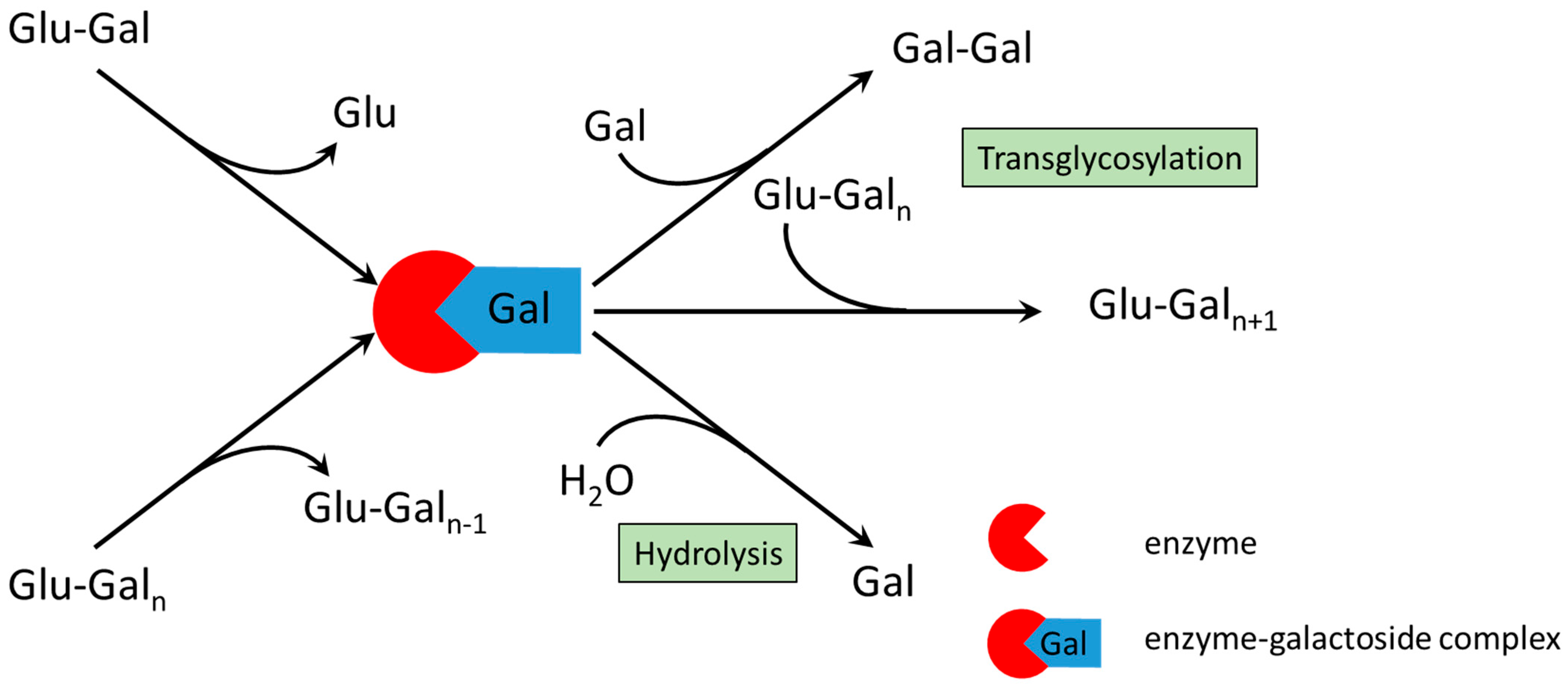
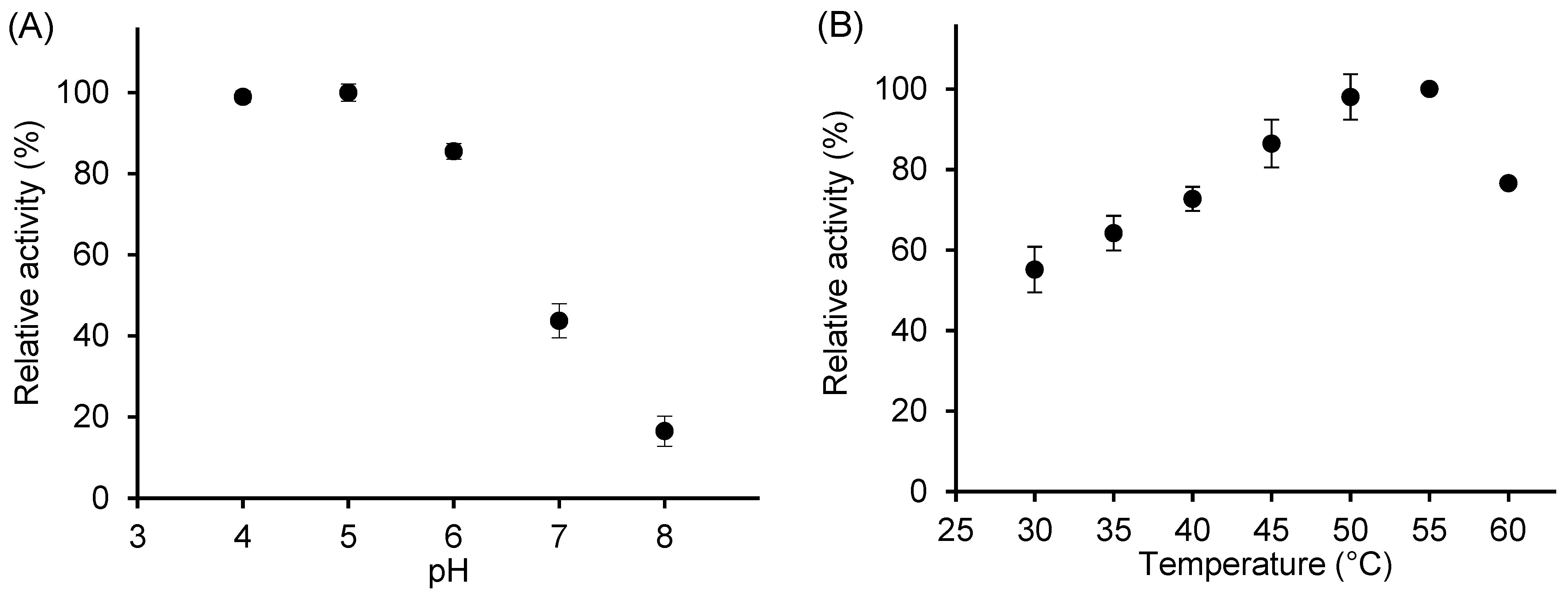
 , Gal ◆), and CAT4 (GOS ✕, Gal
, Gal ◆), and CAT4 (GOS ✕, Gal  ).
).
 , Gal ◆), and CAT4 (GOS ✕, Gal
, Gal ◆), and CAT4 (GOS ✕, Gal  ).
).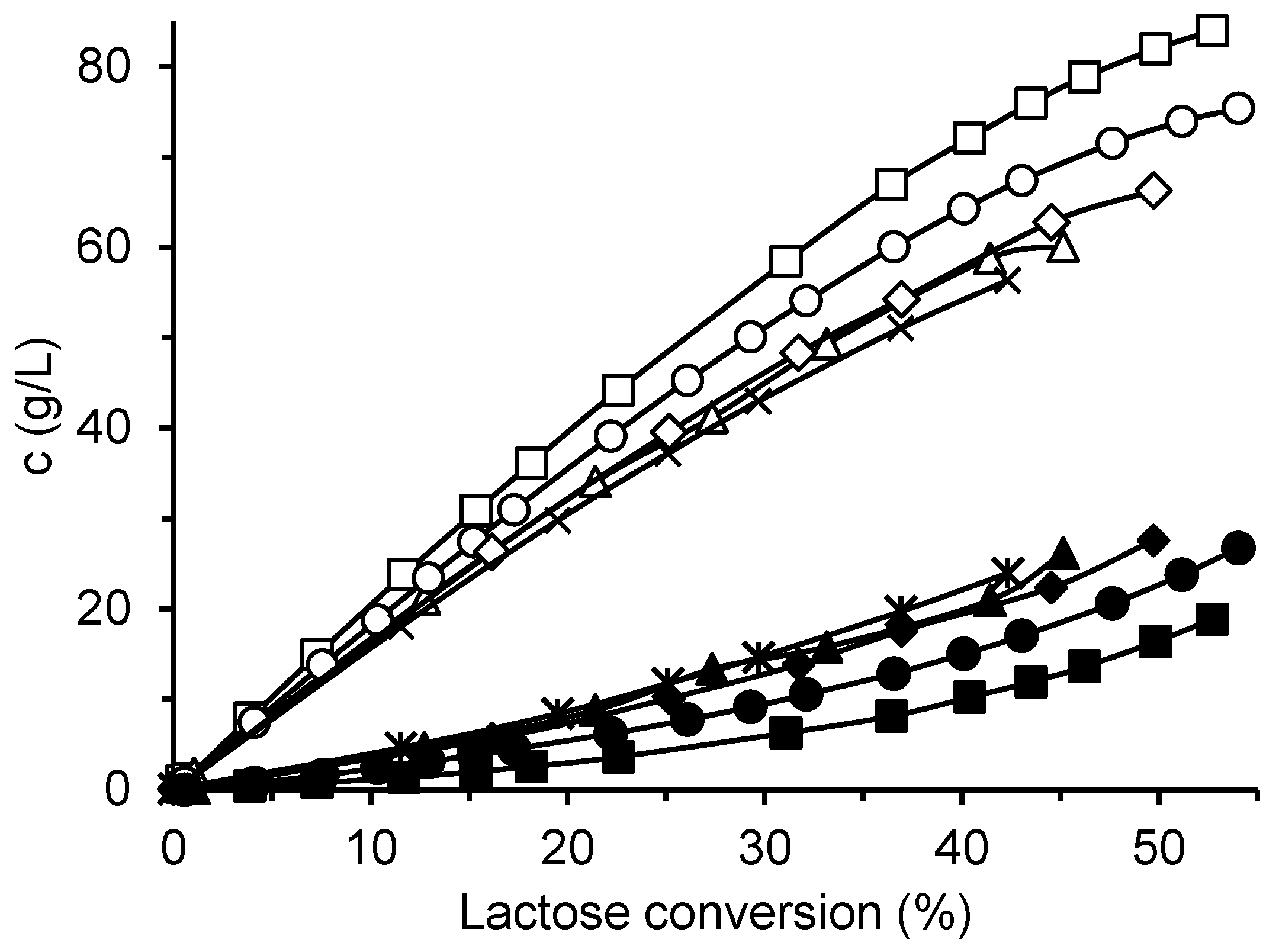

 GOS5,
GOS5,  GOS4, ● GOS3,
GOS4, ● GOS3,  Glb,
Glb,  total GOS,
total GOS,  Gal and
Gal and  Glu (Lines are provided for eye guidance only).
Glu (Lines are provided for eye guidance only).
 GOS5,
GOS5,  GOS4, ● GOS3,
GOS4, ● GOS3,  Glb,
Glb,  total GOS,
total GOS,  Gal and
Gal and  Glu (Lines are provided for eye guidance only).
Glu (Lines are provided for eye guidance only).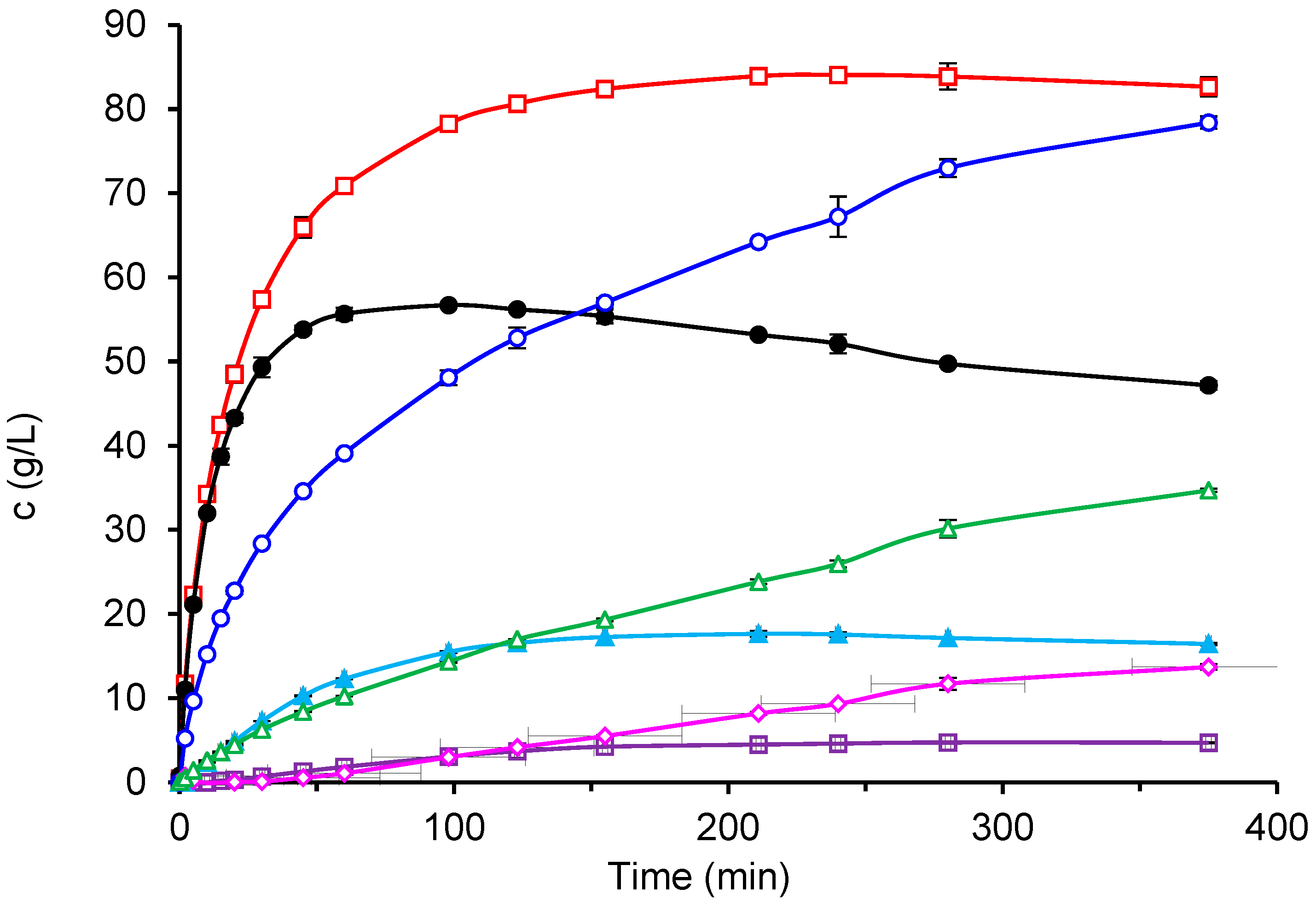
 25 g/L, and ◯ 10 g/L. Reaction conditions: temperature 42 °C, pH 4.5, enzyme concentration 16.7 U/mL (free enzyme) and 4.5 U/mL (CAT2). The percentage of hydrolyzed lactose was calculated as the ratio of galactose formed to the initial lactose concentration.
25 g/L, and ◯ 10 g/L. Reaction conditions: temperature 42 °C, pH 4.5, enzyme concentration 16.7 U/mL (free enzyme) and 4.5 U/mL (CAT2). The percentage of hydrolyzed lactose was calculated as the ratio of galactose formed to the initial lactose concentration.
 25 g/L, and ◯ 10 g/L. Reaction conditions: temperature 42 °C, pH 4.5, enzyme concentration 16.7 U/mL (free enzyme) and 4.5 U/mL (CAT2). The percentage of hydrolyzed lactose was calculated as the ratio of galactose formed to the initial lactose concentration.
25 g/L, and ◯ 10 g/L. Reaction conditions: temperature 42 °C, pH 4.5, enzyme concentration 16.7 U/mL (free enzyme) and 4.5 U/mL (CAT2). The percentage of hydrolyzed lactose was calculated as the ratio of galactose formed to the initial lactose concentration.
 pH 4, □ pH 5, ▲ pH 6, ● pH 7, and ◆ pH 8. Reaction conditions: initial lactose concentration 300 g/L, enzyme concentration 16.6 U/mL (free enzyme), temperature 42 °C.
pH 4, □ pH 5, ▲ pH 6, ● pH 7, and ◆ pH 8. Reaction conditions: initial lactose concentration 300 g/L, enzyme concentration 16.6 U/mL (free enzyme), temperature 42 °C.
 pH 4, □ pH 5, ▲ pH 6, ● pH 7, and ◆ pH 8. Reaction conditions: initial lactose concentration 300 g/L, enzyme concentration 16.6 U/mL (free enzyme), temperature 42 °C.
pH 4, □ pH 5, ▲ pH 6, ● pH 7, and ◆ pH 8. Reaction conditions: initial lactose concentration 300 g/L, enzyme concentration 16.6 U/mL (free enzyme), temperature 42 °C.
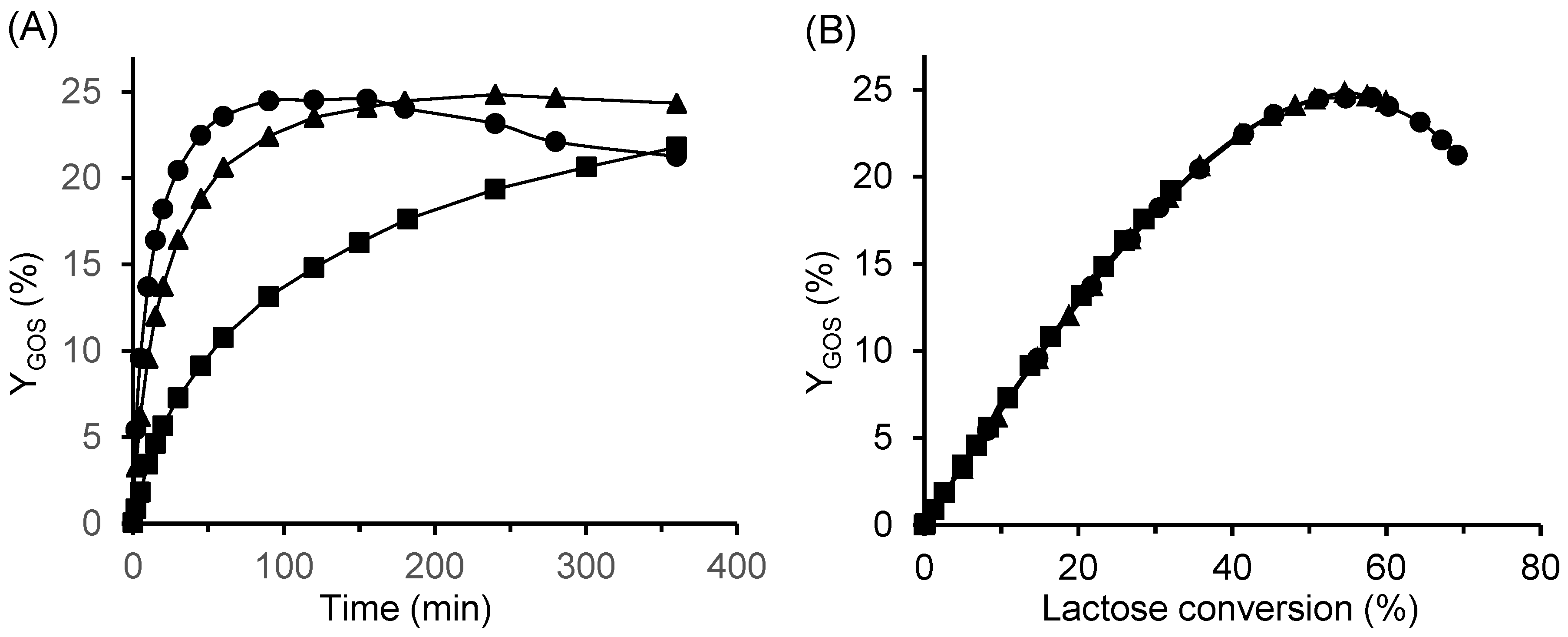

| (U/g) | (%) | (%) | Thiele Modulus * | Effectiveness Factor | |
|---|---|---|---|---|---|
| CAT1 | 148.5 ± 1.1 | 44.4 ± 0.2 | 43.4 ± 2.1 | 16.3 | 0.23 |
| CAT2 | 89.1 ± 1.6 | 19.8 ± 1.0 | 23.5 ± 1.3 | 10.2 | 0.36 |
| CAT3 | 102.0 ± 3.1 | 40.9 ± 1.1 | 48.8 ± 0.6 | 11.5 | 0.32 |
| CAT4 | 65.0 ± 1.2 | 49.1 ± 0.3 | 52.3 ± 1.2 | 7.7 | 0.46 |
Disclaimer/Publisher’s Note: The statements, opinions and data contained in all publications are solely those of the individual author(s) and contributor(s) and not of MDPI and/or the editor(s). MDPI and/or the editor(s) disclaim responsibility for any injury to people or property resulting from any ideas, methods, instructions or products referred to in the content. |
© 2025 by the authors. Licensee MDPI, Basel, Switzerland. This article is an open access article distributed under the terms and conditions of the Creative Commons Attribution (CC BY) license (https://creativecommons.org/licenses/by/4.0/).
Share and Cite
Antošová, M.; Adamíková, J.K.; Polakovič, M. Galactooligosaccharide Production Using Immobilized Aspergillus oryzae β-Galactosidase, Part I: Characterization and Influence of Reaction Conditions. Int. J. Mol. Sci. 2025, 26, 11266. https://doi.org/10.3390/ijms262311266
Antošová M, Adamíková JK, Polakovič M. Galactooligosaccharide Production Using Immobilized Aspergillus oryzae β-Galactosidase, Part I: Characterization and Influence of Reaction Conditions. International Journal of Molecular Sciences. 2025; 26(23):11266. https://doi.org/10.3390/ijms262311266
Chicago/Turabian StyleAntošová, Monika, Jana Krázel Adamíková, and Milan Polakovič. 2025. "Galactooligosaccharide Production Using Immobilized Aspergillus oryzae β-Galactosidase, Part I: Characterization and Influence of Reaction Conditions" International Journal of Molecular Sciences 26, no. 23: 11266. https://doi.org/10.3390/ijms262311266
APA StyleAntošová, M., Adamíková, J. K., & Polakovič, M. (2025). Galactooligosaccharide Production Using Immobilized Aspergillus oryzae β-Galactosidase, Part I: Characterization and Influence of Reaction Conditions. International Journal of Molecular Sciences, 26(23), 11266. https://doi.org/10.3390/ijms262311266






